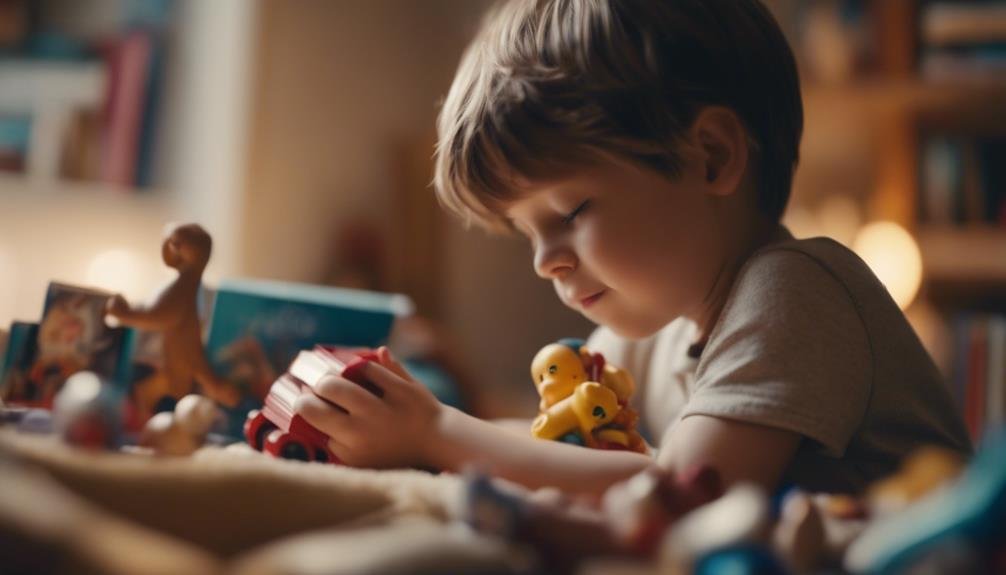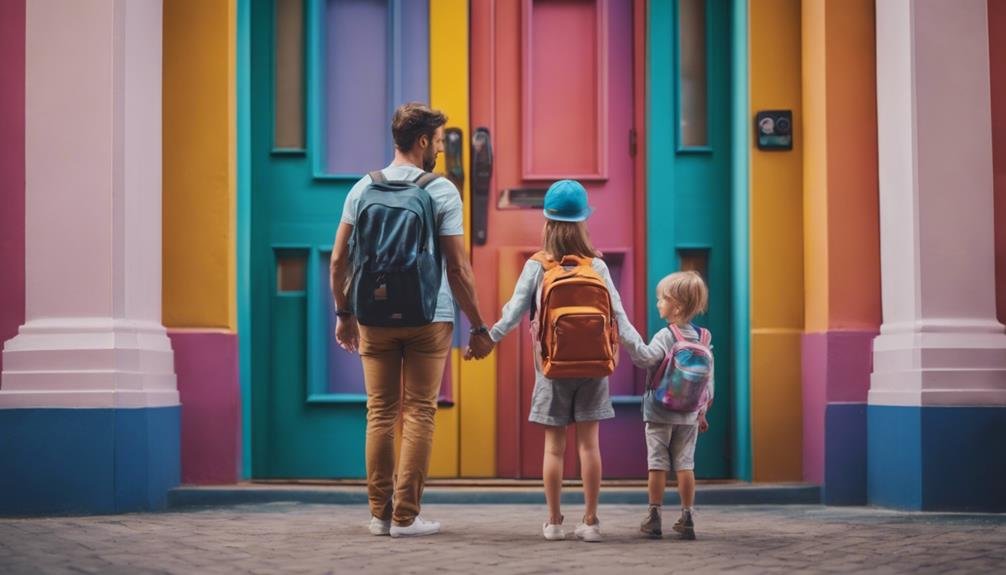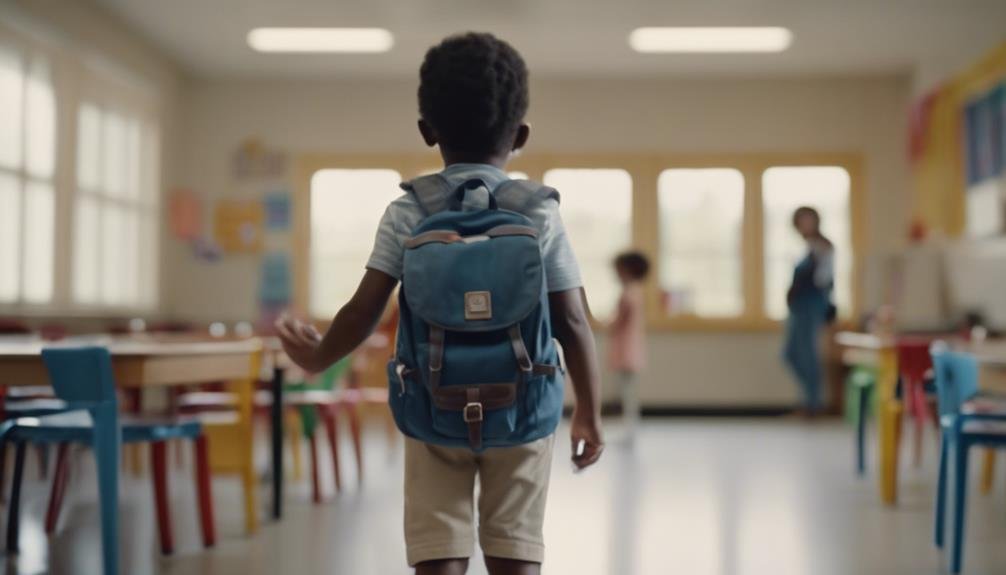"Cherishing Little Steps - A Haven for Baby and Family Journeys"
Strategies for Overcoming Separation Anxiety in Young Children
Imagine separation anxiety as a tangled knot in your child's heart, a knot that needs gentle unraveling. You've tried soothing words and hugs, yet the struggle persists.
What if there were practical strategies that could ease this emotional tug-of-war and bring peace to both you and your little one? Let's explore effective ways to navigate this delicate phase and foster a sense of security and confidence in your child's world.
Key Takeaways
- Parental involvement and validation are crucial for overcoming separation anxiety.
- Consistent routines provide stability and security for children.
- Encouraging independence and empowering children fosters resilience.
- Transitional objects and goodbye rituals can ease separation anxiety effectively.
Understanding Separation Anxiety

If your child is experiencing separation anxiety, understanding the roots of this common childhood issue is essential. Parental involvement plays a significant role in helping your child navigate through these feelings. From the child's perspective, separation anxiety can be overwhelming and scary. Children may fear being away from their caregivers, worrying that something bad might happen to them or their loved ones while they're apart.
As a parent, it's essential to validate your child's emotions and provide reassurance. Let them know that it's okay to feel scared and that you're there to support them. Encouraging open communication can help your child express their feelings and fears effectively. Additionally, involving your child in the process of creating strategies to cope with separation anxiety can empower them and give them a sense of control.
Establishing Consistent Routines
To help your child overcome separation anxiety, establishing consistent routines can provide a sense of stability and predictability in their daily life. Children thrive on routine, and having a structured schedule can help ease their anxiety when faced with separations.
Here are some practical tips to incorporate consistent routines into your child's day:
- Morning rituals: Start the day with a consistent morning routine. Whether it's a special breakfast, a morning walk, or a few minutes of playtime, having a set way to kick off the day can help your child feel grounded and secure.
- Bedtime routine: Establish a calming bedtime routine that signals the end of the day and prepares your child for sleep. This could include activities like brushing teeth, reading a bedtime story, or cuddling before lights out. Consistency in these actions can help your child feel safe and secure as they drift off to sleep.
Building Trust Through Predictability

Establishing trust through predictability in your child's daily routines can greatly help in easing separation anxiety and providing a sense of security. Parental involvement is key in creating routines that your child can rely on. By consistently following a schedule for meals, naps, playtime, and bedtime, you're showing your child that you're dependable and that they can trust you to meet their needs.
Predictable routines also contribute to emotional security. When your child knows what to expect throughout the day, they feel more stable and less anxious. This predictability helps them develop a sense of safety and comfort, which are essential for overcoming separation anxiety.
Incorporating small rituals or cues before changes, such as a special goodbye hug or a favorite song before naptime, can further enhance the predictability of daily routines. These rituals provide additional reassurance and strengthen the bond between you and your child, fostering a sense of security that can help ease separation anxiety.
Encouraging Independence in Daily Tasks
To help your child build confidence and resilience, encourage their independence in daily tasks by providing opportunities for them to take on small responsibilities and make choices on their own. This fosters autonomy and promotes self-reliance, essential skills for maneuvering the world with confidence.
Here are some practical ways to encourage independence in your child's daily routine:
- Assign age-appropriate tasks: Give them simple chores like putting away toys or setting the table. This helps them feel capable and responsible.
- Offer choices: Allow them to make decisions about what to wear or which snack to have. This empowers them and builds decision-making skills.
- Praise their efforts: Acknowledge their attempts even if they don't get it perfect. Encouragement boosts their self-esteem and motivates further attempts.
- Set clear expectations: Communicate what you expect from them clearly. This clarity helps them understand their role and responsibilities.
Creating a Reassuring Goodbye Ritual

Creating a reassuring goodbye ritual can help ease your child's separation anxiety and provide them with a sense of security and predictability in your departures. Parent involvement is key in establishing this ritual. Before saying goodbye, take a few moments to connect with your child emotionally. Sit down together, maintain eye contact, and use a calm and soothing tone to reassure them that you'll return.
Incorporate small gestures like a secret handshake, a special phrase, or a goodbye hug that your child can look forward to each time you leave. These rituals create a sense of closeness and comfort, making the separation easier for your little one. Encourage your child to express their feelings and share any worries they may have about your departure. Acknowledge their emotions and provide reassurance that you'll always come back.
Using Transitional Objects
Using intermediary objects can be a comforting way to help your child feel secure during times of separation. Intermediary objects provide a sense of comforting familiarity and emotional security, acting as a bridge between you and your child when you're not physically together. Here are some tips on how to effectively utilize intermediary objects:
- Introduce Early: Start introducing an intermediary object early on, like a favorite stuffed animal or a small blanket, so your child can form a strong attachment to it.
- Encourage Bonding: Encourage your child to bond with the object by allowing them to bring it along during outings or sleep times, reinforcing the association between the object and comfort.
- Respect the Connection: Respect the importance of the intermediary object in your child's life and avoid dismissing its significance, as it provides emotional security during separations.
- Provide Reassurance: Use the intermediary object as a tool to provide reassurance and comfort to your child whenever they feel anxious or upset about being apart from you.
Practicing Short Separations

How can you gradually help your child adjust to short separations in a supportive manner? One effective way is by implementing gradual exposure and providing positive reinforcement. Start by practicing short separations for brief periods and gradually increasing the time apart as your child becomes more comfortable. This approach helps in building resilience and fostering emotional regulation in your little one.
To make this process smoother, consider the following strategies:
| Strategies | Description |
|---|---|
| Set a routine | Establish a predictable schedule for separations, so your child knows what to expect and feels secure. |
| Create a goodbye ritual | Develop a special goodbye routine that reassures your child and makes the separation feel more manageable. |
| Use a timer | Use a visual timer to show your child how long you'll be apart, helping them understand the concept of time. |
| Offer a reward system | Encourage your child with small rewards or praise for successfully maneuvering short separations. |
| Practice self-care | Take care of yourself too, as children pick up on your emotions; staying calm can help them feel more at ease. |
Communicating Openly and Reassuringly
To help your child navigate through short separations more smoothly, it's important to openly communicate with them in a reassuring manner. Here are some strategies to assist you in effectively communicating with your child during times of separation:
- Listen attentively: Be present and attentive when your child expresses their feelings about separation. Acknowledge their emotions and validate their concerns.
- Use simple language: Explain the separation using simple and reassuring language that your child can easily understand. Avoid using complex or vague explanations.
- Offer physical comfort: Provide hugs, cuddles, or a comforting touch to reassure your child of your presence and support during the separation.
- Create a routine: Establish a goodbye routine that involves saying a special phrase, giving a token of comfort, or engaging in a familiar ritual to help your child feel secure and prepared for the separation.
Seeking Support From Teachers and Caregivers

When seeking support from teachers and caregivers for your child's separation anxiety, remember that open communication and collaboration are key to providing a supportive environment. Parent involvement is vital in helping educators understand your child's needs and triggers. By sharing insights about your child's behavior at home, you can equip teachers with valuable information to support them better at school. Establishing school partnerships is also essential; work together with teachers to create a consistent routine that shifts smoothly between home and school settings.
| Parent Involvement | School Partnerships |
|---|---|
| Share insights about your child's behavior at home | Collaborate with teachers to create a consistent routine |
| Communicate openly about your child's anxieties | Work together to develop strategies for coping with separation |
| Attend school meetings and discuss progress | Establish a support network involving teachers and caregivers |
| Provide feedback on strategies that work at home | Encourage open communication between all parties |
| Collaborate on techniques to ease separation anxiety | Celebrate small victories together as a team |
Celebrating Small Victories
After establishing a solid foundation with teachers and caregivers, it's important to recognize and celebrate the small victories your child achieves in overcoming their separation anxiety. Seeing progress, no matter how small, can be a significant morale boost for both you and your little one.
Here are some ways to celebrate these achievements:
- Acknowledge Efforts: Take a moment to praise your child for their bravery in facing their fears.
- Create a Reward System: Implement a simple reward system for each milestone they reach in managing their anxiety.
- Celebrate Together: Share in their joy by celebrating these victories as a family.
- Encourage Self-Reflection: Help your child see how far they've come by reflecting on the progress they've made.
Frequently Asked Questions
How Can Parents Address Their Own Feelings of Guilt or Anxiety When Leaving Their Child With Separation Anxiety?
Feeling guilt or anxiety when leaving your child with separation anxiety is tough. Remember, self-care matters. Lean on support networks for comfort. Therapy can help. Coping strategies like deep breathing or positive affirmations can ease your worries.
Are There Any Specific Strategies for Helping a Child Who Experiences Separation Anxiety at Bedtime?
You're not alone in facing bedtime battles with your little one. Establishing a calming bedtime routine, providing comfort objects, and gradually easing separation can help. Lean on parental support, stay consistent, and offer reassurance. You've got this!
What Are Some Ways to Address Separation Anxiety in a Child Who Is Starting Daycare or Preschool for the First Time?
When starting daycare or preschool, involve parents in the change and encourage coping skills. Provide support through positive reinforcement. Acknowledge the child's feelings and offer reassurance. Establish routines and communicate openly to ease separation anxiety and help the child adjust positively.
How Can Parents Navigate Separation Anxiety When Traveling or Going on Vacation With Their Young Child?
When traveling or vacationing with your little one, remember: "Absence makes the heart grow fonder." Ease separation anxiety by establishing routines, bringing comforting items, staying connected through calls or video chats, and involving them in trip planning.
Are There Any Recommended Resources or Books for Parents Looking to Learn More About Separation Anxiety in Young Children?
As you navigate separation anxiety in your child, consider exploring parenting workshops and online forums. Learning about child psychology and parenting techniques from recommended resources and books can offer valuable insights and strategies for support.
Conclusion
You've got this! Remember, like a caterpillar emerging from its cocoon, your child too will grow and thrive through separation anxiety.
By implementing the strategies mentioned, you're laying the groundwork for their independence and resilience.
Stay consistent, communicate openly, and celebrate those small victories along the way.
Together, you and your little one will navigate this challenging time and emerge stronger on the other side.
Keep going, you're doing great!


